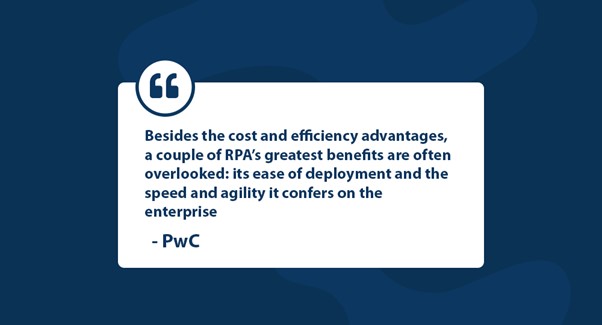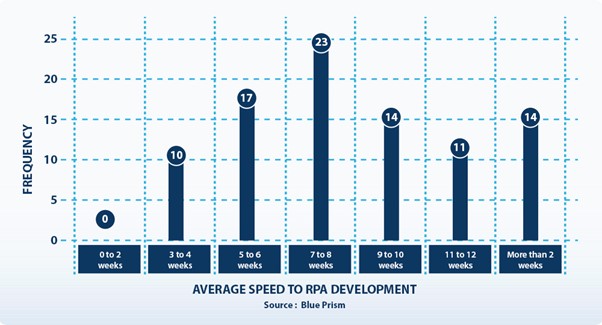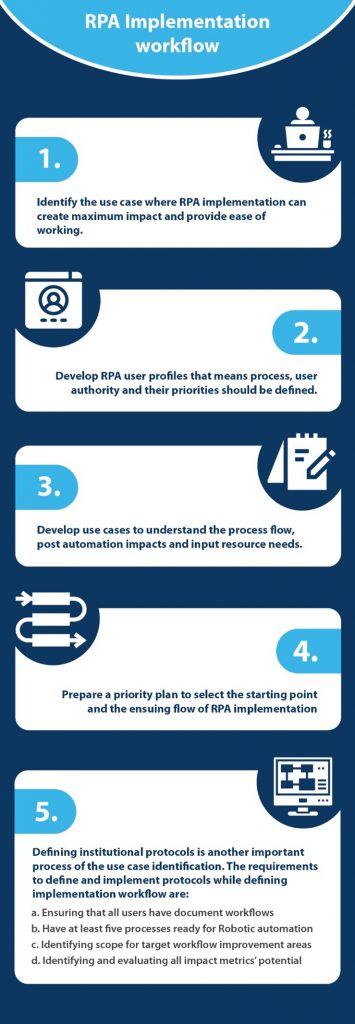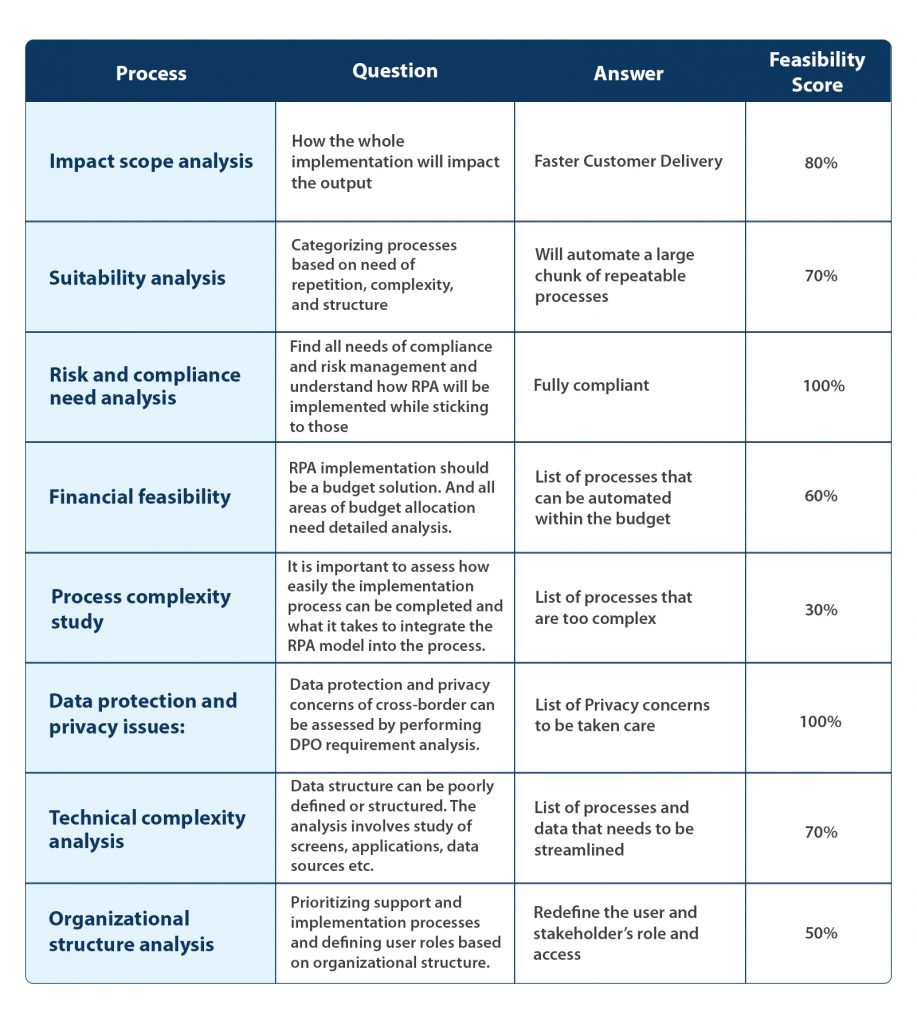RPA stands for Robotic Process Automation; We all know it. But things that have remained untouched for many users about RPA implementation requirements, practices worth knowing about, and ways to implement RPA in a business-centric manner. So, in this post, we intend to walk you through:

RPA can benefit businesses in the following ways:
So, let us explore these reasons one by one!
Every process is designed keeping returns in mind. RPA is not an exception either. Businesses aim to capture the largest possible chunk of market share. It can become possible only when the processes streamline the workflow, reduce wastage, and adopt an automated format. The final outcomes are better productivity, more orders per year, and eventually, more profits per work cycle.
Employees’ time that goes into repetitive processes may be used to better quality jobs with RPA implementation. RPA can perform operations five times faster and with no deviation from pre-fed instructions. Thus, nil error helps complete more process cycles any given workday.
Employees do feel frustrated when they are evaluated based on jobs that do not complement their expertise. Repetitive processes and those which involve only following certain instructions cannot provide any employee job satisfaction. RPA implementation offers employers the correct environment for using the workforce as per their expertise. It reflects the deepened loyalty of the employees to their organizations.
RPA implementation can help achieve higher accuracy in rule-based processes. A typical rule-based process flow can be automated up to 70-80% with RPA. Since there are no repetitions and rechecks required, the manufacturers can roll out applications in the market faster than in previous instances.
Planning must have an element of intuition in the processes. In sectors like banking and insurance, RPA supports intuitive processes’ planning. Digitization was introduced with an aim to ease the processes and give quicker services. With the help of intuitive process planning empowered by RPA, the businesses involved in public dealing can give a seamless user experience to the customers.
It is a common experience that any upgrade can be included in the work ecosystem only when it is most easy to do so. RPA implementation exhibits the same requirement.
Quick-to-roll and easily employable by all, the RPA solutions take no more than a couple of weeks to implement. Cygnet Infotech which is designing and delivering RPA solutions makes the following observations as regards to the feasibility of RPA implementation:
Other points to consider while analyzing the feasibility of RPA are:
To sum up,
Businesses are familiar with Business Process Re-engineering. And, feel that this is it. The feasibility of RPA becomes easy to achieve and proves to be a practical process when it is seen as an activity that complements the benefits of BPR. If it is looked upon as a replacement for BPR, the initial reaction may be that of not adopting the process.

Businesses felt the need to supplement BPR with something more quick, seamless, advanced, and feasible. RPAs characteristically fulfill all these criteria. Of the various advantages, the biggest plus is that the RPA helps reduce human efforts and does not require too many changes in the existing process framework.
The other commendable advantages of implementing RPA are:
For example, in the sectors such as retail and real estate, the RPAs are fed with the questions that form the part of natural interactions between entities internal and external to businesses. The chatbots resolving sales enquiries, and managing customers and visitors in an intuitive tone are classic examples of CRM RPAs.
As an RPA user, you must know about both rule-based and cognitive automation. The rules-based automation process is designed to reduce complications, remove human error, and to ensure industry-governed procedures. With the help of rules-based RPA models, the implementation experts can provide reliable support for:
In essence, wherever intelligence and decision-making are not required, one can adopt rules-based RPA models and achieve better performance in terms of quality, speed, usability, and compliance.
Cognitive RPA models take the processes beyond rules-based. The RPAs with cognitive abilities are empowered with tools like AI, Machine Learning, Deep Thinking, Text Analytics, Natural Language Processing, Optical Character Recognition, etc.
So, cognitive RPAs work for those areas where intelligence is a prerequisite for better quality outputs.
The following requirements are ought to be fulfilled for implementing cognitive RPAs:
Rule-based and cognitive automation have a divided patronage. Some experts call cognitive automation the future and have already got the names for it – hyper-automation, intelligent automation, AI process automation, etc. There is still a chunk of experts that say that rule-based automation is the only practically feasible form of RPA and that cognitive automation is too futuristic. It is believed to be still in its nascent stage and adoption needs a lot of shifts of perspectives and technology upgrades.
Since the implementation of RPA will receive welcome gestures only when the process is simple and effortless, the experts have stipulated that one should go for RPA implementation only when the processes have the following characteristics.
Rule-based: The process must be based on a specific set of rules. For example, in the insurance claims settlement process, the considerations are constant. Hence, as soon as the specifications are met, the process initiates automatically when RPA is implemented.
High volume: RPA implementation serves the needs most correctly when the process to be automated requires handling large volumes of orders concurrently.
Error-Prone: A minuscule typo or shuffling of digits can cause huge losses especially when money is involved. Hence, RPA should be employed in those cases where erroneous entries need to be avoided.
Speed sensitive: Customer experience is one of the main objectives of RPA implementation. This experience can be created in a high-quality manner when it carries an element of immediacy. RPAs in customer service or in the form of CRM chatbots can give quick resolution, collect consents for order processing and provide order status instantly. It helps provide customers the assurance they need.
Requiring temporary workers: Replacing humans with machines works best when the project is not of constant nature. If the staff is required only for a specific time period, businesses can reduce employee expenses by assigning such jobs to automated machines.
Access our Free BOTs and start automating a bunch of your repetitive processes in a minute
To make RPA implementation possible, the experts suggest the following workflow:
Defining institutional protocols is another important process of use case identification. The requirements to define and implement protocols while defining implementation workflow are:

As a part of the pre-and post-implementation process, the RPA experts need to perform some crucial analyses. These points of analysis include (mentioned on the basis of priority attached):

From RPA to DPA – Pega
Every industry now has conditions that are conducive to the successful implementation of RPA. Some of the proven use cases are:
While selecting the right RPA implementation partner, the business owners/managers must evaluate the following points:
While selecting the right RPA implementation partner, the business owners & managers must evaluate the following points:
RPA implementation is one of the best things happening around. Businesses are required to be digitally transformed and they have a lot of opportunities to explore with the correct tools in hand.
However, it really depends on the complexity involved in business processes. Along with cost factors, small and medium enterprises may find it difficult to design an ideal RPA journey.
Hence, using the RPA implementation partner is a correct and wise decision. They can identify the RPA implementation needs and areas, and help businesses make decisions which are in the best interest of the businesses.
